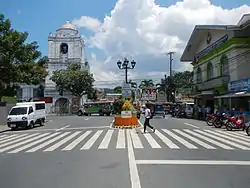Pagsanjan
Pinagsangahan | |
|---|---|
| Municipality of Pagsanjan | |
 Downtown area | |
 Flag  Seal | |
Nicknames:
| |
| Motto(s): Negosyo Palakasin, Trabaho Padamihin AASENSO PAGSANJAN! | |
 Map of Laguna with Pagsanjan highlighted | |
OpenStreetMap | |
.svg.png.webp) Pagsanjan Location within the Philippines | |
| Coordinates: 14°16′N 121°27′E / 14.27°N 121.45°E | |
| Country | Philippines |
| Region | Calabarzon |
| Province | Laguna |
| District | 4th district |
| Founded | December 12, 1668 |
| Barangays | 16 (see Barangays) |
| Government | |
| • Type | Sangguniang Bayan |
| • Mayor | Cesar V. Areza |
| • Vice Mayor | Terryl O. Gamit-Talabong |
| • Representative | Maria Jamina Katherine B. Agarao |
| • Municipal Council | Members |
| • Electorate | 31,210 voters |
| Area | |
| • Total | 26.36 km2 (10.18 sq mi) |
| Elevation | 149 m (489 ft) |
| Highest elevation | 492 m (1,614 ft) |
| Lowest elevation | 1 m (3 ft) |
| Population (2020 census)[3] | |
| • Total | 44,327 |
| • Density | 1,700/km2 (4,400/sq mi) |
| • Households | 11,404 |
| Economy | |
| • Income class | 3rd municipal income class |
| • Poverty incidence | 2.34 |
| • Revenue | ₱ 190.6 million (2020) |
| • Assets | ₱ 258.1 million (2020) |
| • Expenditure | ₱ 162.7 million (2020) |
| • Liabilities | ₱ 49.97 million (2020) |
| Service provider | |
| • Electricity | First Laguna Electric Cooperative (FLECO) |
| Time zone | UTC+8 (PST) |
| ZIP code | 4008 |
| PSGC | |
| IDD : area code | +63 (0)49 |
| Native languages | Tagalog |
| Website | www |
Pagsanjan (pronounced PAG-sang-han), officially the Municipality of Pagsanjan (Tagalog: Bayan ng Pagsanjan), is a 3rd class municipality in the province of Laguna, Philippines. According to the 2020 census, it has a population of 44,327 people.[3]
Situated 4 kilometres (2.5 mi) from Santa Cruz and 91 kilometres (57 mi) southeast of Manila, this town can reach via Manila East Road or Slex. Pagsanjan is the tourist capital of Laguna and is the home of the Bangkero Festival held every March. The bangkeros are tour guides who steer boats along the river to Pagsanjan Falls (also called Magdapio Falls), for which the town is well known but is actually in neighboring Cavinti.[5][6]
Pagsanjan was the capital of the province of Laguna for 170 years (1688–1858) during which the town prospered as the commercial, cultural and learning center of the province.[7]
Etymology
Pagsanjan is located in the riparian delta formed by the confluence of the Balanac and Bumbungan rivers. Originally called Pinágsangahán ("branching" or "juncture"), this was shortened to "Pagsanjan" by early Spanish colonists because they found the name very difficult to pronounce.
History

Pagsanjan was originally a barrio of Lumban. In 1668, eight Japanese and Chinese traders, who were highly impressed by the strategic location of the barrio at the juncture of Balanac and Bumbungan, rivers founded the town. They established a trading settlement and engaged in the betel nut industry. In time, the barrio became the flourishing trading center of eastern Laguna and attracted families from the surrounding communities of Cavinti and Pila. On December 12, 1668, then-Governor-General Juan Manuel de la Peña Bonifaz issued a decree elevating its status to a town. In 1688, Pagsanjan replaced Bay as the capital of the province. It remained such until 1858, during which it bloomed as the cultural and commercial center of the province.[8]
Geography
Pagsanjan has a land area of 26.4 square kilometres. It is bounded on the east by the Balubad Mountain; on the west by the capital town of Santa Cruz; on the north by the San Isidro Hill and Laguna de Bay; on the north-east by the town of Lumban; on the southeast by the towns of Cavinti and Luisiana; on the south by Mount Banahaw; and on the south-west by the town of Magdalena.
Barangays
Pagsanjan is politically subdivided into 16 barangays. [9] Each barangay consists of puroks and some have sitios.
Climate
| Climate data for Pagsanjan, Laguna | |||||||||||||
|---|---|---|---|---|---|---|---|---|---|---|---|---|---|
| Month | Jan | Feb | Mar | Apr | May | Jun | Jul | Aug | Sep | Oct | Nov | Dec | Year |
| Mean daily maximum °C (°F) | 26 (79) |
27 (81) |
29 (84) |
31 (88) |
31 (88) |
30 (86) |
29 (84) |
29 (84) |
29 (84) |
29 (84) |
28 (82) |
26 (79) |
29 (84) |
| Mean daily minimum °C (°F) | 22 (72) |
22 (72) |
22 (72) |
23 (73) |
24 (75) |
25 (77) |
24 (75) |
24 (75) |
24 (75) |
24 (75) |
24 (75) |
23 (73) |
23 (74) |
| Average precipitation mm (inches) | 58 (2.3) |
41 (1.6) |
32 (1.3) |
29 (1.1) |
91 (3.6) |
143 (5.6) |
181 (7.1) |
162 (6.4) |
172 (6.8) |
164 (6.5) |
113 (4.4) |
121 (4.8) |
1,307 (51.5) |
| Average rainy days | 13.4 | 9.3 | 9.1 | 9.8 | 19.1 | 22.9 | 26.6 | 24.9 | 25.0 | 21.4 | 16.5 | 16.5 | 214.5 |
| Source: Meteoblue[10] | |||||||||||||
Demographics
| Year | Pop. | ±% p.a. |
|---|---|---|
| 1903 | 6,361 | — |
| 1918 | 7,538 | +1.14% |
| 1939 | 8,865 | +0.78% |
| 1948 | 9,282 | +0.51% |
| 1960 | 10,691 | +1.18% |
| 1970 | 14,556 | +3.13% |
| 1975 | 16,188 | +2.15% |
| 1980 | 19,489 | +3.78% |
| 1990 | 25,024 | +2.53% |
| 1995 | 28,999 | +2.80% |
| 2000 | 32,622 | +2.56% |
| 2007 | 35,944 | +1.35% |
| 2010 | 39,313 | +3.31% |
| 2015 | 42,164 | +1.34% |
| 2020 | 44,327 | +0.99% |
| Source: Philippine Statistics Authority[11][12][13][14] | ||
In the 2020 census, the population of Pagsanjan was 44,327 people,[3] with a density of 1,700 inhabitants per square kilometre or 4,400 inhabitants per square mile.
Economy
Culture
Pagsanjan March
The official song of the town is the Pagsanjan March. The anthem was composed by Rogel Taiño, a native of Pagsanjan.
Notable personalities
- Gregorio F. Zaide - historian and author, "Dean of Filipino Historiographers"
- Pedro Pelaez - educator and priest, considered the "Father of Filipinization of the Church" and "The Godfather of the Philippine Revolution"
- Leandro H. Fernández - educator, author and historian
- Francisco Benitez - First Dean of University of the Philippines College of Education, educator and author, husband of Paz Marquez Benitez
- Conrado Benitez - First Dean of the College of Liberal Arts at the University of the Philippines, educator and author, one of the drafters of the 1935 Constitution.
- José Fabella - Filipino physician and a public health advocate, Father of Public Health and Social Welfare in the Philippines.
- Gelia Tagumpay Castillo – National Scientist of the Philippines for Rural Sociology[22]
- Ernesto Maceda - former councilor of Manila, former senator, columnist and lawyer
- Mario Montenegro - actor
- Louie Ignacio - TV director
- E.R. Ejército - Actor, 17th Governor of Laguna and former Mayor of Pagsanjan
See also
References
- ↑ Municipality of Pagsanjan | (DILG)
- ↑ "2015 Census of Population, Report No. 3 – Population, Land Area, and Population Density" (PDF). Philippine Statistics Authority. Quezon City, Philippines. August 2016. ISSN 0117-1453. Archived (PDF) from the original on May 25, 2021. Retrieved July 16, 2021.
- 1 2 3 Census of Population (2020). "Region IV-A (Calabarzon)". Total Population by Province, City, Municipality and Barangay. Philippine Statistics Authority. Retrieved 8 July 2021.
- ↑ "PSA Releases the 2018 Municipal and City Level Poverty Estimates". Philippine Statistics Authority. 15 December 2021. Retrieved 22 January 2022.
- ↑ "Pagsanjan, Laguna – The Tourist Capital of Laguna". Retrieved 2020-01-17.
- ↑ "The Philippine Star". Retrieved 2020-01-17.
- ↑ Pagsanjan Official Site Archived 2011-07-27 at the Wayback Machine
- ↑ "Pagsanjan, Laguna – The Tourist Capital of Laguna". Retrieved 2020-01-17.
- ↑ "Province: Laguna". PSGC Interactive. Quezon City, Philippines: Philippine Statistics Authority. Retrieved 12 November 2016.
- ↑ "Pagsanjan: Average Temperatures and Rainfall". Meteoblue. Retrieved 11 May 2020.
- ↑ Census of Population (2015). "Region IV-A (Calabarzon)". Total Population by Province, City, Municipality and Barangay. Philippine Statistics Authority. Retrieved 20 June 2016.
- ↑ Census of Population and Housing (2010). "Region IV-A (Calabarzon)" (PDF). Total Population by Province, City, Municipality and Barangay. National Statistics Office. Retrieved 29 June 2016.
- ↑ Censuses of Population (1903–2007). "Region IV-A (Calabarzon)". Table 1. Population Enumerated in Various Censuses by Province/Highly Urbanized City: 1903 to 2007. National Statistics Office.
{{cite encyclopedia}}: CS1 maint: numeric names: authors list (link) - ↑ "Province of Laguna". Municipality Population Data. Local Water Utilities Administration Research Division. Retrieved 17 December 2016.
- ↑ "Poverty incidence (PI):". Philippine Statistics Authority. Retrieved December 28, 2020.
- ↑ "Estimation of Local Poverty in the Philippines" (PDF). Philippine Statistics Authority. 29 November 2005.
- ↑ "2003 City and Municipal Level Poverty Estimates" (PDF). Philippine Statistics Authority. 23 March 2009.
- ↑ "City and Municipal Level Poverty Estimates; 2006 and 2009" (PDF). Philippine Statistics Authority. 3 August 2012.
- ↑ "2012 Municipal and City Level Poverty Estimates" (PDF). Philippine Statistics Authority. 31 May 2016.
- ↑ "Municipal and City Level Small Area Poverty Estimates; 2009, 2012 and 2015". Philippine Statistics Authority. 10 July 2019.
- ↑ "PSA Releases the 2018 Municipal and City Level Poverty Estimates". Philippine Statistics Authority. 15 December 2021. Retrieved 22 January 2022.
- ↑ "Philippine Institute for Development Studies". pids.gov.ph. Retrieved 2020-04-20.

.svg.png.webp)